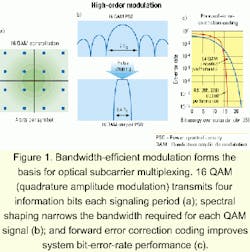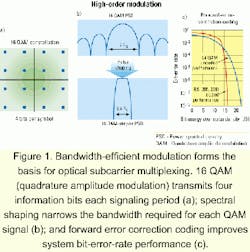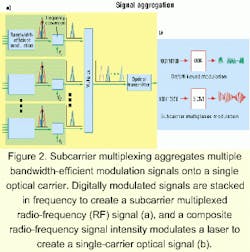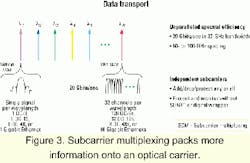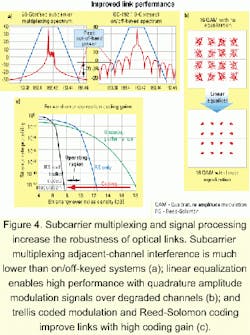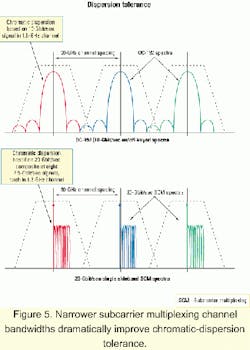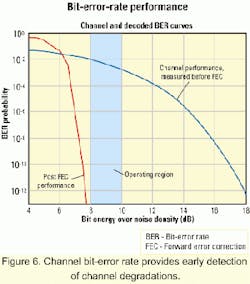Subcarrier multiplexing: more than just capacity
The use of higher-order modulations together with subcarrier multiplexing provides inherent capabilities and features highly attractive to network operators.
DR. TED WOLCOTT and HEIDI THELANDER, Centerpoint Broadband Technologies
Demand for more flexible bandwidth creation at lower cost is causing service providers to look at alternative and complementary technologies to traditional TDM and WDM systems. Subcarrier multiplexing (SCM) provides an additional dimension of multiplexing to increase the efficiency and flexibility of optical transport networks. It has largely been promoted as an approach for increasing capacity and bandwidth efficiency on a given fiber or wavelength with its use of bandwidth-efficient digital modulation and sublambda grooming. However, SCM and the architectures it enables provide many additional capabilities that network planners are waiting for.
SCM, sometimes referred to as "frequency-division multiplexing," has been used in radio, satellite, and cable-TV applications at much lower data rates for many years, providing low-cost, highly bandwidth-efficient physical-layer transport. Recent developments in high-rate digital signal processing and radio-frequency (RF) component capabilities have enabled the application of this technology to optical-networking systems that have just begun to require such high levels of bandwidth efficiency.
Optical SCM technology is the result of the combination of several key elements, all considered proven technology in their other applications:
- Higher-order modulation for bandwidth efficiency.
- Pulse shaping for spectral efficiency.
- Forward-error-correction (FEC) coding for bit-error-rate (BER) performance.
- RF signal multiplexing and demultiplexing.
- Broadband optical intensity modulation.
SCM technology is more than digital processing; the key to many of the performance benefits is actually the RF processing that is performed on the already modulated signals. These individual channels, all output from digital modems at a single intermediate frequency, are frequency converted and filtered to a series of equally spaced offset subcarrier frequencies (f1, f2, ... fk). The offset subcarriers are combined or multiplexed together, creating a single composite RF signal consisting of k independent subcarriers (see Figure 2a). This RF signal is then used to intensity modulate the laser, creating a single wavelength optical signal carrying k independent subcarrier channels (see Figure 2b).
Systems have been developed with these technologies that provide up to 20 Gbits/sec of data transmission on a single wavelength in as little as 32 GHz of spectrum (see Figure 3); equivalent SONET TDM systems require 60 GHz. With linear external modulators, standard International Telecommunication Union (ITU)-grid lasers are used to transmit these signals at any desired ITU wavelength. Systems have been constructed, providing 32 subcarriers capable of transmitting 32 OC-12/OC-12c signals or eight OC-48/OC-48c signals on a single wavelength. In addition, these individual wavelength signals can be fed into WDM systems to provide even greater capacity per fiber.SCM provides superior bandwidth efficiency and overall capacity to the much simpler OOK systems. However, capacity and bandwidth efficiency alone will not answer many network operators' needs. Some additional inherent features that provide a new level of flexibility are:
- Linear and ring configurations, which enable add/drop, drop/continue, regeneration, and broadcast/drop (fanout) of individual subcarriers.
- Transparency, providing multiple service types in native format-with carrier-class protection.
- Highly flexible traffic mix that carries any combination of IP, ATM, and SONET signals.
- SONET-like protection performance without SONET overhead on each individual channel.
- Interoperability with TDM and WDM equipment, creating flexible, scalable, and robust networks.
In addition to the features produced by the architecture, a number of performance benefits are obtained through implementation of this type of system. These include:
- Straightforward network-link design -no optical-link budget adjustments with subcarrier provisioning.
- Improved system robustness with reduced adjacent channel interference and link performance enhancements due to equalization and FEC.
- Lower susceptibility to polarization-mode dispersion and chromatic dispersion than 10-Gbit/sec TDM systems.
- Highly insightful performance monitoring with many valuable metrics from digital signal processing.
- Excellent fault isolation capability due to metrics and architecture.
The functionality of an optical-networking system determines the level of flexibility it provides to both the network designer and the network operator. SCM systems can be architectured for a high level of functionality in a number of areas.
With low-cost RF processing, the SCM system can be configured to support both linear and ring network configurations. Nodes can be configured as linear terminals, ring add/drop multiplexers (ADMs), or regeneration elements, allowing traffic to be set up as add/drop, drop and continue, regenerated, or broadcast and drop (fanout) for individual subcarriers-and reconfigured as needed. Linear configurations are then easily created to provide 1+1 protection for application to regional point-to-point interconnects, capacity expansion of thin fiber routes, or to supplement capacity on existing long-haul routes where fiber type currently limits the ability to increase TDM speeds. Metro rings can be configured with ADMs (and regenerators as needed) to provide unidirectional path-switched ring protection for the metro core or collector ring applications where capacity growth is rapid, yet service mix difficult to predict.
In addition to supporting a variety of applications with these configurations, the digital and RF processing inherent in SCM provide a level of visibility together with data transparency that is unique. The digital processing performed yields a great deal of insight into the performance of the link on a given channel with metrics ranging from uncoded channel BER to received signal-to-noise ratio. That enables SONET-level protection to be provided on any traffic type carried by an SCM system. Since all traffic is digitally modulated, all traffic can be protected with less than 50-msec switching to a protect channel, including native IP data traffic without SONET framing or digital wrappers.The RF processing performed in the SCM system provides the transparency network operators seek. Each channel can independently carry traffic operating at different rates. Any traffic type can be carried transparently, and systems have been designed that carry SONET, ATM, and IP traffic seamlessly on the different subcarriers.
This transparency provides the network operator with the ability to reconfigure the system easily and quickly as the service mix changes without swapping out a lot of equipment. The rise of Gigabit Ethernet as a service provided by carriers is pushing demand for flexible systems that enable transitions, and SCM eliminates the need for equipment to convert non-SONET signals into SONET signals.
Because SCM is effectively orthogonal to TDM and WDM, the technologies are inherently interoperable. SCM adds another dimension to the space network operators can choose from to implement capacity. On the tributary side, SCM systems can, and indeed must, be designed to provide complete compatibility to SONET TDM signals. The use of standard lasers supporting the established ITU-grid wavelengths enables SCM systems to be combined with WDM for very-high-capacity systems with superior flexibility, providing subwavelength granularity while supporting multiple services in their native format.
With so many technologies being applied to optical networking, traditional notions of performance standards are being challenged and adapted. Network design is more challenging at higher rates, over more wavelengths, for longer distances. Any edge in simplifying network design through enhanced or more robust performance can make a real difference to designers-and to cost. SCM with digital signal processing for bandwidth-efficient modulation provides some significant performance benefits to optical networks.
Optical-link budgets can be difficult to maintain through a network that, despite standards used for initial design, has a range of channel conditions across its spans; each change can mean having to take a new look at the link budgets. However, the optical power for an SCM signal remains constant, no matter how many subcarrier channels are in service. By modulating a common light source with the aggregate signal, the optical power is a function of the laser, not the number of channels in the signal. Any power not used by a channel is returned to the unmodulated portion of the SCM waveform, which enables the add/drop of subcarriers without reengineering the link.
The SCM and BEM signal processing combination also provides a high level of robustness in system link performance over a wide range of channel conditions. Because of the pulse shaping and filtering of the subcarriers, SCM signals have very low adjacent-channel interference (see Figure 4a). Unlike an OOK signal, the spectral sidelobes of an SCM signal are negligible-an ideal SCM signal will have no sidelobes at all, whereas nonlinearities in any practical SCM modulator will produce small sidelobes well below those of an OOK signal. This lack of out-of-band power results in very low adjacent-channel interference in DWDM systems.
The digital signal processing in the SCM modems provides additional robustness with linear equalization to improve signals received through varied channels and with FEC more powerful than that used in other optical systems. The relatively low subcarrier clock rate allows the implementation of multitap, fractionally spaced linear equalizers at each receiver to combat linear distortion in the channel (see Figure 4b). The improved signal quality results in lower BER in highly distorted channels.
Many optical systems are now employing linear block-code FEC, typically Reed-Solomon block codes. However, with binary signaling, the full power of FEC cannot be tapped. SCM's use of higher-order modulation allows the traditional Reed-Solomon FEC to be paired with trellis coded modulation (TCM), a form of FEC that takes advantage of the modulation format to maximize the coding gains (see Figure 4c). Together, these codes provide coding gains of 7 dB or more.A critical performance edge is found in the area of dispersion tolerance. Chromatic dispersion impairs performance of all high-rate OOK signals, and therefore must be compensated for every link and channel in many optical networks. The higher the bit rate, the wider the signal bandwidth, the lower the chromatic-dispersion tolerance. Likewise, the longer the fiber span, the greater the chromatic dispersion. To avoid expensive or complex chromatic-dispersion compensation, networks must be limited in either data rate or distance.
Single-sideband (SSB) SCM eliminates the need for chromatic-dispersion compensation in all but the longest optical networks, even at very high aggregate bit rates. By eliminating the energy on one side of the optical carrier, the chromatic-dispersion tolerance is limited only by the symbol rate of the individual subcarriers-not by the aggregate signal bandwidth. Thus, a 20-Gbit/sec SCM signal, operating with OC-48 rate subcarriers, will exhibit chromatic-dispersion tolerance far exceeding that of a 10-Gbit/sec OC-192 system, and even that of an OC-48 system (see Figure 5).
Polarization-mode dispersion (PMD) is another impairment that gets worse with increased bandwidth. Unfortunately, SSB does not help in this case. However, the inherent bandwidth efficiency of an SCM signal limits the impact of PMD. A 20-Gbit/sec SCM signal exhibits greater PMD tolerance than an OC-192 signal. At 10 Gbits/sec, the PMD tolerance of SCM approaches that of an OC-48 signal. In networks where PMD is the primary limitation, an SCM signal can be designed to maximize the PMD tolerance.
Extensive performance metrics provided by the digital signal processing together with a decentralized architecture provide SCM systems with a very high level of performance monitoring and fault-isolation capabilities on traffic of all types. Use of TCM and Reed-Solomon coding allow monitoring of both channel BER performance (before decoding) and decoded BER performance (see Figure 6).
The channel BER is much higher in the operating region, providing BER degradation information to the operator as gradual or slight degradations occur, well before they accumulate to result in an outage. That provides a valuable maintenance corrective-action tool to avoid costly downtime on service-level agreements. SCM systems also provide superior fault isolation and correction as compared to other technologies. Together with proper fault correlation, SCM isolates problems down to the card level as well as corrects and increases the reliability of the various traffic protocols.
While SCM clearly provides the capability to increase optical-network capacity and improve fiber bandwidth efficiency, it also provides many other potential benefits to the optical-network designer and operator. The underlying digital signal processing, RF processing, and optical modulation technologies combine to provide a wide range of advantages in the network.
Flexibility in configuration and traffic mix combined with true transparency and carrier-class protection of all traffic reduces operations cost and improves provisioning. Highly robust optical links with constant optical power together with highly informative performance metrics and lower susceptibility to dispersions make SCM systems easier and less costly to design and maintain. Sub carrier multiplexing is clearly part of the future of optical networks-providing more than just capacity.
Dr. Ted Wolcott is director of systems and research and development and Heidi Thelander is senior product marketing manager at Centerpoint Broadband Technologies (San Jose, CA). They can be reached at [email protected] and [email protected], respectively.
